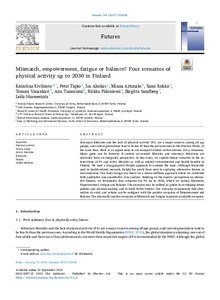Mismatch, empowerment, fatigue or balance? Four scenarios of physical activity up to 2030 in Finland
Kiviluoto Katariina; Tapio Petri; Ahokas Ira; Aittasalo Minna; Kokko Sami; Vasankari Tommi; Tuominen Anu; Paloniemi Riikka; Sandberg Birgitta; Hurmerinta Leila
https://urn.fi/URN:NBN:fi-fe2022121371248
Tiivistelmä
Sedentary lifestyles and the lack of physical activity (PA) are a major concern among all age groups, and current generations tend to be less fit than the previous ones in the Western World. At the same time, there is an urgent need to cut transport-related carbon dioxide (CO2) emissions. Major gains can be foreseen if current car-centred lifestyles and sedentary behaviour are addressed from an integrated perspective. In this study, we explore future scenarios in the intersections of PA and active lifestyles as well as related environmental and health benefits in Finland. We used a disaggregative Delphi approach to examine the topic. Although frequently used in health-related research, Delphi has rarely been used in exploring alternative futures or non-consensus. The study design was based on a mixed-methods approach where we combined both qualitative and quantitative data analysis. Building on the experts’ perceptions on alternative futures, we formulated four scenarios for PA up to 2030, which we named Mismatch, Empowerment, Fatigue and Balance. The scenarios may be utilised as guides in developing future policies and decision-making, and to build better futures. Our scenarios demonstrate that alternatives do exist, and actions can be realigned with the positive scenarios of Empowerment and Balance. The physically inactive scenarios of Mismatch and Fatigue represent avoidable scenarios.
Kokoelmat
- Rinnakkaistallenteet [27094]
